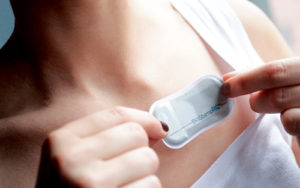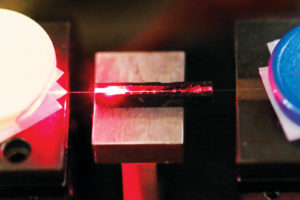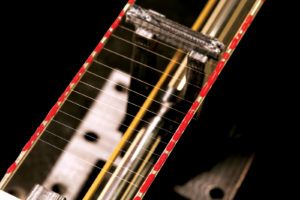Flexible data collectors that can be worn on (and eventually, in) the body have great promise for patient-focused health care, but there are privacy concerns.

The market for smart sensors is expected to grow from $18.58 billion in 2015 to more than $57 billion by 2022, according to a report published this summer by MarketsandMarkets (marketsandmarkets.com). Wearable technology is a significant product area for the industry, with applications ranging from medical and health clothing to sports, leisure and fitness gear. Within this market, biometric clothing is firmly establishing itself in divergent consumer sectors, from luxury fashion brands such as Ralph Lauren to big box stores like Best Buy Canada. This clothing can offer the wearer valuable data, although more controversially it can also provide information to trainers, insurers and manufacturers themselves.
In August the University of Michigan signed a major sponsorship deal with NIKE, worth an estimated $170 million. Privacy concerns have been raised about a clause in the contract that would allow the sportswear brand to gather players’ biometric data. Similar questions are being raised in almost every market sector that uses wearable technology in which data gathering, processing and storage is involved. While the issue of safeguarding personal privacy may take some time to resolve, smart and—in particular—soft or flexible sensors continue their technological development.
Temporary tattoos?
Flexibility and stretch are commonly spoken of together, but in textile and technology terms they require quite different approaches. Slim substrates allow for high flexibility; stretch requires a more engineered (such as geometric or net) structure, such as a fabric structure. In mimicking both the flexibility and stretch of human skin, temporary sensor tattoos offer the possibility of creating devices that are soft, bendable and relatively unobtrusive to wear. They act as a ‘second skin,’ offering real-time monitoring with data transmitted wirelessly to a smartphone or other device.
The process involves silk-screen printing active inks such as carbon and silver/silver chloride (Ag/AgCl). These devices are ideally positioned to utilize sweat-monitoring ions contained in perspiration to check for sodium levels (an indicator of cystic fibrosis), calcium levels (bone mineral loss; osteoporosis) and pH (skin health and dehydration). Researchers at the University of California, San Diego, are developing a lactate tattoo biosensor for use in sports. Lactate is an indicator of tissue oxygenation that, if found to be above normally occurring levels, can indicate the presence of performance-enhancing drugs. Coaches and sports physicians traditionally use blood draws from the finger, so the use of a temporary tattoo would offer a non-invasive alternative.
The patch
Researchers at a group of universities in Thailand are developing fabric-based gas sensors with a wide range of possible applications. Using two techniques, embroidery and drop-coating, sensing chemicals are deposited onto interdigitated electrodes (IDEs) pre-prepared using conductive thread embroidered onto a fabric substrate. Trials have been undertaken with a number of volatile compounds (ammonium hydroxide, ethanol, etc.) commonly found in wastes released from the human body. The “e-nose” allows for the identification of odors from different people and between various regions of the body. From a health standpoint, this could offer a less obtrusive alternative to more rigid sensors, helping to diagnose conditions such as diabetic nephropathy, diabetes mellitus, cirrhosis of the liver and liver cancer. In security applications, the technology could be used for quality control in the cosmetics, food and beverage industries. It could also help in the detection of prohibited substances and explosive materials.
The cosmetics industry is embracing wearable technology and linking it to a smartphone app in the case of French cosmetics manufacturer La Roche-Posay®, a subsidiary of L’Oréal. Developed with the Boston, Mass., start-up MC10 Inc., My UV Patch aims to “increase understanding and awareness around the effects of sun exposure and UV rays on the skin.” The transparent adhesive stretch patch can be applied directly onto the skin. Its photosensitive dyes change color when exposed to UV radiation, and the app allows the user to avoid over-exposure and get hints on when to reapply sunscreen. A common complaint with wearable tech and biometric devices in particular is that they tell people what they already know; but UV light is not visible to the naked eye. This is a truly smart design that provides new and actionable information on how to foster more positive user behavior in the sun.
MC10 Inc. has also collaborated with a Belgian company, UCB (“Inspired by patients. Driven by science.”), to develop a patient-focused disease management solution using the start-up’s BioStamp platform based on UCB’s own specially developed stretchable electronics. BioStampRC™ (Research Connect) is a discrete patch that can be worn where required on the body to gather targeted data such as heart rate, body temperature and movement. MC10 co-founder Roozbeh Ghaffari sees the device as having the potential to help in the tracking of Parkinson’s Disease and heart failure. It’s designed to be easy to use for both patient and medical professional, with both tablet and web applications available. Ultimately, Ghaffari sees the technology leading toward a new generation of implants, and even new designs in pacemakers housed inside the body.
Skin, stretch and silk

At Cornell University, Ithaca, N.Y., researchers led by Dr. Rob Shepherd are developing uniaxial stretch sensors that emit light using hyperelastic light-emitting capacitors (HLEC), where hydrogel electrodes are embedded in silicone rubber. Using the growing discipline of biomimicry, with engineering solutions and design inspiration coming from nature, an artificial high-stretch skin is being developed that will illuminate to indicate changes in internal and external pressure. Cephalopods, such as the octopus, have organs that change color to control posture and adopt camouflage. With potential applications in health, transportation and communication, because the research is being undertaken in the university’s Organic Robotics Lab, a primary focus is on the development of soft robots. Linked to artificial intelligence (AI) and the creation of caretaker/companion robots for elderly people, this technology could allow future robots to display artificial emotions through blushing and other markers. The group is also developing dielectric elastomer sensors (DES) to create pressure-sensitive skins that would allow soft robots to feel external touch stimulus and their own shape. Early developments include a programmable haptic (relating to the sense of touch) interface with potential applications in prosthetics.

as a chemical detector.
Photo: © Alain Herzog / EPFL.
Spider silk has long been admired for its strength, resilience and flexibility. Researchers in the fiber optic group at the Ecole Polytechnique fédérale de Lausanne (EPFL) in Switzerland are examining its potential as a chemical sensor. Because the structure of the strands is cylindrical, smooth, transparent and solid, the material offers many of the attributes of glass fibers; but unlike glass fibers, the helix-like structure of the spider silk makes it sensitive to chemical substances. Dr. Jacques Thévenaz, leading the research, describes how “the helix in the silk unwinds whenever polar molecules like acetic acid and ammonia come into contact with the bonds … [so that it] modifies the ways the strands conduct light.” The alteration is fully reversible, and because the silk is biodegradable, it has the potential to be used as a sensor inside the body without the need for a later surgical procedure to remove it.
Invisible electronics
One of the challenges facing wearable technology is how to provide sophisticated levels of data without complexity in the user interface. As soft sensors become increasingly flexible, invisible to the eye and touch, they offer the potential for the consumer to harvest data in a way that is easy and unobtrusive. Thomas Ducellier, executive director of the Canadian government’s Printable Electronics flagship program, sees the industry “entering an era of invisible electronics that enable us to know more about ourselves and the environment around us.” In the future, Ducellier sees further developments emerging in printed and hybrid electronics including sensors. Yarn-based sensors and sensors that incorporate microfluidics could offer bio-chemical analyses and diagnostics. These and other engineering and manufacturing advances promise a whole new generation of discrete sensors that can be worn outside—and ultimately inside—the human body.
In motion
To see online videos of some of the projects discussed in this article:
My UV Patch
www.laroche-posay.us/my-uv-patch
The BioStampRC™ soft sensor
www.mc10inc.com
In development at Dr. Shepherd’s lab, Cornell University:
Stretchable electroluminescent skin
vimeo.com/156004610
A kinesthetic sensor
vimeo.com/141455735
 TEXTILES.ORG
TEXTILES.ORG


